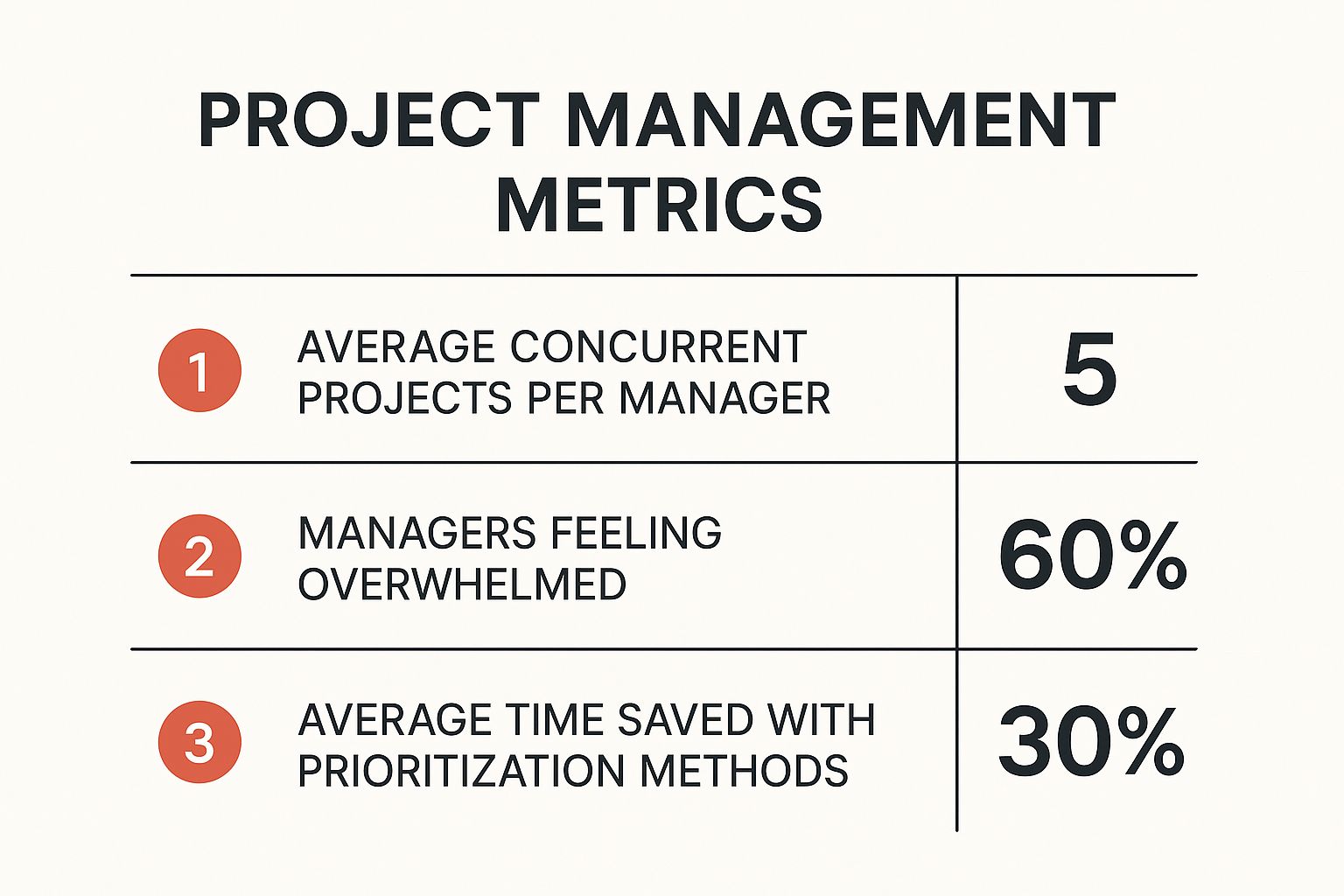If you're running a growing agency, you know the feeling. Managing one big client project is tough enough. Juggling ten at once? It can feel like you're just trying to keep the wheels from flying off.
The secret to managing multiple projects isn't about finding a better to-do list app. It’s about building a solid, repeatable system. You need a framework that lets your agency shift from constantly putting out fires to proactively steering the ship, all while balancing client needs, your team's sanity, and creative quality.
The Agency Challenge of Juggling Multiple Client Projects
For any agency, the constant flood of competing priorities is the single biggest threat to both growth and profitability. It's a high-stakes balancing act. Every client thinks they're your only client, and every deadline feels like it was due yesterday. This isn’t a simple time management problem you can solve with a few productivity hacks; it's a deep-seated operational issue that requires a complete strategic overhaul.
The pressure is immense. The core challenge is a lot like trying to execute effective strategies for managing multiple social media accounts—one small slip-up can have a ripple effect that impacts several clients at once.
This infographic paints a pretty clear picture of the daily pressure agency project managers are under.

These numbers don't lie. Most agency managers are completely swamped, but there's hope. A disciplined approach to prioritizing can actually free up a huge chunk of their workweek.
The Real Cost of Inefficiency for Your Agency
This constant project juggling isn't just stressful; it's incredibly expensive for your agency. Think about it: research shows that over 85% of project managers are tasked with multiple projects simultaneously. It's just part of the job description in an agency setting.
But here's the kicker: inefficiencies in how those projects are run cause nearly 10% of every single dollar invested in projects to be wasted globally. For an agency, that’s a direct hit to your profit margin, simply because of poor processes.
To give you a clearer path forward, we've broken down our approach into four core pillars. This is the foundation for taking back control and running a more profitable, less chaotic agency.
Four Pillars of Multi-Project Mastery for Agencies
This guide is designed to give you an actionable framework built on these very principles. By putting them into practice, your agency can gain immediate control, boost team morale, and deliver outstanding work for every client—without all the chaos.
Pillar 1: Build a Centralized Mission Control for All Agency Projects

We’ve all been there. Project briefs are buried in one person's inbox, crucial client feedback is lost in a sea of Slack messages, and the only copy of the timeline is on a whiteboard that hasn't been updated in weeks. That’s not project management; it's just organized chaos.
If you want your agency to truly get a handle on how to manage multiple projects, your first and most important move is to create a centralized mission control.
Think of it as your agency’s operational headquarters. It’s the single source of truth where every stakeholder—from the project manager to the creative team and even the client—can instantly find what they need. No more "just checking in" emails. Just clarity.
Standardize Your Client Project Intake Process
A strong mission control is built on a foundation of clean, consistent data. This process needs to kick off the very second a new client project gets the green light. Forget relying on messy email chains or someone's scribbled notes from the kickoff call. It's time to create a standardized intake form for every project.
This isn't just about bureaucracy; it's about setting projects up for success from day one. Your form should capture every critical detail right out of the gate:
- Key Objectives: What does a "win" actually look like for this client project?
- Stakeholders: Who are the key contacts on the client side and within your agency?
- Deliverables: What, specifically, is your team on the hook to create?
- Deadlines: Nail down the final delivery date and all major milestone deadlines.
Using a standard form ensures nothing critical slips through the cracks. It cuts out the ambiguity that so often leads to endless back-and-forth, giving your team the clear runway they need to start executing.
Choose Your Agency's Command Center Software
Once you’ve got your intake process locked down, you need a home for all that information. This is where dedicated project management software becomes absolutely essential for any agency. There's a reason the market for these tools is projected to hit $12.02 billion by 2030—they work. In fact, a staggering 82% of companies already depend on work management software to keep their operations running smoothly.
Platforms like Asana, Monday.com, or Trello are popular choices for building this command center. The ultimate goal is to have a master dashboard or calendar that gives you a bird's-eye view of all major deadlines across every single client.
A common mistake I see agencies make is picking a tool that’s way too complex. The best system is the one your team will actually use consistently. It's better to start simple and add features only when you genuinely need them.
Finally, you need to connect this hub to your other systems. This is where the magic really happens. An AI meeting assistant like Scribbl can automatically pull action items and key decisions from client calls and send them directly to your project management tool. This simple connection eliminates manual data entry, cuts down on human error, and guarantees that verbal agreements actually turn into trackable tasks.
Pillar 2: Master Ruthless Prioritization for Client Work

In the agency world, it’s all too easy for the squeakiest wheel to get all the grease. A demanding client lights up your inbox with "urgent" requests, and before you know it, the whole team has dropped their planned work to put out the latest fire. This reactive cycle is a total productivity killer.
When every task is treated as a top priority, nothing is a priority.
To get a real handle on managing multiple client projects, your agency has to get comfortable with ruthless—but objective—prioritization. This isn't about ignoring clients. It's about strategically deciding where to invest your team's finite time and energy to make the biggest impact. It means moving beyond gut feelings and using a real framework to back up your decisions.
From Urgent to Important: Applying the Eisenhower Matrix in an Agency
It’s a classic for a reason. The Eisenhower Matrix forces you to sort tasks based on two simple things: urgency and importance. For agencies, this framework is a godsend for cutting through the noise of client demands and focusing on what actually moves the needle.
Here’s how it breaks down for an agency context:
- Urgent & Important (Do Now): These are the genuine emergencies. Think a major client's website crashing right before a holiday sale or a critical campaign launch that's happening today. These tasks need immediate, focused attention.
- Important & Not Urgent (Schedule): This is where real, strategic growth happens for your agency and your clients. We're talking about long-term planning for a flagship account, developing a new service offering, or finally improving that clunky internal process. You have to actively schedule and protect time for this work.
- Urgent & Not Important (Delegate): These are the distractions disguised as priorities. A client needs a minor copy tweak on a low-traffic page, or you’re stuck with routine admin work. Find someone else to handle these and free up your key players.
- Not Urgent & Not Important (Eliminate): These are the time-wasters. That "nice-to-have" internal project with no clear ROI? Ditch it.
By sorting tasks this way, you gain instant clarity. The goal for a successful agency is to spend most of its time in the "Important & Not Urgent" quadrant. That’s how you start steering the ship instead of just bailing water.
Go Deeper with Value vs. Effort Scoring for Client Tasks
While the Eisenhower Matrix is a great starting point, agency life is often more nuanced. Sometimes you have two "important" client tasks staring you down. That's where Value vs. Effort scoring comes in. This method helps you objectively compare tasks that might otherwise seem equally critical.
For every potential task on your list, assign it a score (say, from 1 to 5) for two categories:
- Value: How much will this task impact the client's goals and your agency's bottom line? High-value work might be something that generates a killer case study, helps lock in a retainer, or significantly boosts a client's core KPIs.
- Effort: How many resources will this task chew up? Think about team hours, hard costs, and overall complexity.
Picture this: A newer, high-maintenance client wants a quick website banner change (Low Value, Low Effort). At the same time, your anchor client needs a complex but game-changing analytics report built out (High Value, High Effort). The banner feels urgent because the client is noisy, but the report is what builds a true partnership and secures long-term revenue.
The Value vs. Effort model makes the decision for you. You focus on the high-value report and communicate a reasonable timeline for the banner. This is how you master the strategic "not right now" without torching the client relationship. When you can explain your priorities using a logical framework, you build trust and save your team from burnout.
Pillar 3: Delegate Work to Empower Your Agency Team

With your priorities locked in, the real make-or-break moment in juggling multiple projects is learning to delegate effectively. For a lot of agency leaders, this is a massive hurdle. It’s so easy to fall into the trap of thinking it's just faster or safer to do it yourself. But that mindset is a fast track to becoming the bottleneck and burning out your best people—and yourself.
Let's be clear: smart delegation isn't about just offloading the tasks you don't want. It’s a strategic move to empower your agency team. It means matching the right person to the right task, giving them the autonomy to truly own it, and equipping them with everything they need to succeed without you hovering over their shoulder. Get this right, and you'll build a more capable, confident team and free yourself up to focus on the big-picture agency strategy.
Match the Right Task to the Right Team Member
Great delegation starts long before you assign anything. It's about knowing your team beyond their job titles. Before you even think about handing off a task for a client project, pause and consider a few key things.
- Skills and Strengths: Who’s the natural fit here based on their expertise? Even better, is there someone who's been itching to grow in this specific area?
- Current Workload: This is a big one. Check your project hub. Who actually has the bandwidth? Piling work onto someone who's already swamped is a surefire way to get missed deadlines and subpar results.
- Career Aspirations: Could this task be a real growth opportunity for a junior team member? Giving someone a challenge shows you trust them, and that’s a powerful motivator in an agency setting.
This isn't just about getting work done; it's a powerful tool for team development. And as more agencies embrace distributed teams, having these clear communication channels is more critical than ever. It's worth exploring proven strategies for managing remote teams to build a solid framework for these multi-project environments.
Craft Delegation Briefs That Actually Empower Your Team
Nothing kills project momentum faster than a vague, one-line instruction. If you want to truly empower your agency team, you have to master the art of the clear delegation brief. Every single task you hand off needs a concise, comprehensive brief that leaves zero room for misinterpretation.
A classic agency mistake is assuming everyone has the same context you do. When you delegate, you're not just assigning work; you're transferring ownership. They need all the pieces of the puzzle to make smart decisions on their own.
A solid brief should always include:
- The "Why": Why does this task matter? Briefly explain how it connects to the bigger client project goals.
- Clear Objectives: What does "done" look like? Define the specific, measurable outcome you're expecting.
- Key Deadlines: Be crystal clear about the final due date and any important check-in points along the way.
- Relevant Resources: Link up everything they'll need—files, documents, client notes, you name it.
Use Technology to Share Unwritten Context with Your Team
One of the trickiest parts of delegation is transferring all that "unwritten" context—the stuff that comes up in client conversations and meetings. This is where the right tech becomes a total game-changer for an agency. Imagine using an AI meeting assistant like Scribbl to transcribe a client brainstorming session.
Now, when you delegate a task that came out of that call, you can just share the complete, searchable transcript. Suddenly, your team member doesn't just have the "what" (the task); they have the "why" behind it. They can see the client's exact phrasing, understand their tone, and review the other ideas that were floated. This level of context is gold, empowering them to execute with confidence and true understanding. For a deeper dive, our post on how to delegate tasks effectively has even more practical tips.
Pillar 4: Track Progress with Radical Transparency for Clients and Team
You can't manage what you don't measure. In an agency, a lack of visibility is a huge source of anxiety for both your team and your clients. You need clear, consistent rhythms for tracking progress and sharing updates across all projects. This isn't about micromanagement; it's about building client trust through transparency.
The goal is to finally break free from chaotic, last-minute status requests and those endless "just checking in" email chains. Instead, you create a predictable system where everyone—from your newest hire to your biggest client—knows exactly where each project stands. This proactive approach builds client confidence and keeps your internal teams aligned and accountable.
Establish a Predictable Agency Communication Rhythm
Consistency is your secret weapon. To really get a handle on multiple projects, your agency needs a communication schedule that everyone can set their watch by. This rhythm ensures information flows predictably, cutting down on guesswork and stopping small issues from snowballing into major headaches.
Think about a weekly schedule that mixes different communication styles. This keeps everyone in the loop without creating a calendar full of time-sucking meetings.
Here’s a sample communication rhythm we’ve seen work wonders for busy agencies:
Sample Agency Communication Rhythm
A simple structure like this ensures information gets shared regularly, keeping everyone on the same page. The key is to make these touchpoints hyper-efficient and focused so they actually support the work instead of interrupting it.
One of the biggest mistakes I see agencies make is waiting for the client to ask for an update. By the time they have to ask, they’re already worried. Proactive, scheduled communication turns you from just another vendor into a trusted partner who’s always one step ahead.
Use Technology for Radical Transparency with Clients
Technology is what brings a transparent agency workflow to life. Modern project management dashboards are so much more than glorified to-do lists; they are real-time windows into the health of a project. Simply giving stakeholders access to a live dashboard can eliminate dozens of check-in emails every single week.
AI meeting assistants are another incredibly powerful tool in your transparency arsenal.
Imagine your account manager wraps up a key client call. Instead of blocking off an hour to write and polish notes, an AI tool like Scribbl instantly generates a concise summary, outlines the key decisions made, and lists out every single action item.
This summary can be shared immediately with both the project team and the client, creating an instant, objective record of the conversation. That simple step keeps everyone perfectly aligned and accountable, turning verbal agreements into trackable tasks in your project hub. To dig deeper into how tech can boost your agency's output, check out our guide on how to improve team collaboration.
This isn't just about being more efficient. It's about creating a single source of truth that aligns every single project with your agency's bigger picture. In fact, a staggering 80% of project managers see this as essential for success. They know that when everyone has access to the same information, projects don't just get done—they deliver real business value for their clients.
Answering Common Agency Project Management Questions
Even with the slickest systems, running multiple agency projects always throws a few curveballs. Agency leaders, new and old, constantly bump up against the same handful of challenges: juggling talent, picking the right tools, and fending off the dreaded scope creep.
Let's get into some of the most persistent questions I hear and offer some real-world advice that goes beyond the textbook answers.
How do we allocate resources when multiple projects need our lead designer?
Ah, the classic agency logjam. Every client account needs your best people, and they need them yesterday. The first step toward sanity isn't a magic formula; it's just getting a clear picture of reality. You need a master calendar or a resource management dashboard in your PM tool that shows, at a glance, who’s at capacity and who’s drowning. You can't make smart calls if you're flying blind.
Once you can see the whole board, it's time to prioritize with a clear head. Use a framework like the Value vs. Effort model we talked about earlier. This forces you to be objective about which project actually moves the needle most for the agency, rather than just giving the designer to whichever account manager is being the squeakiest wheel.
For those constant conflicts, try time-blocking. Maybe your lead designer dedicates Mondays and Wednesdays to Client A, and Tuesdays and Thursdays to Client B. The most critical part? Proactively communicate timelines to clients based on your team's real availability. Setting realistic expectations upfront saves you from so many headaches down the line.
What is the best way to handle scope creep from a demanding client?
Your best defense against scope creep is a good offense, and that means a painfully specific Statement of Work (SOW). Before a single pixel is pushed or a line of code is written, that SOW needs to be detailed, agreed upon, and signed. It’s the foundation everything else is built on.
When a client inevitably asks for "just one more thing" that's outside that SOW, your team's gut reaction can't be to just say "yes" to keep them happy. That's a fast track to burnout and lost profits. Instead, you need a formal, no-exceptions change request process.
This isn't just red tape; it's a professional way to re-center the conversation. The change order document should clearly spell out:
- Exactly what the new request is.
- How it will affect the project deadline.
- Any extra costs tied to the new work.
This simple process transforms the request from a casual ask into a business decision, forcing the client to weigh the a-la-carte item against its impact. Using an AI tool to document the initial scope from kickoff calls is also a lifesaver here—it gives you an undisputed transcript to refer back to if they claim, "we talked about this!"
How do we choose the right project management tool for our agency?
It’s easy to get mesmerized by tools with a million flashy features you'll never actually use. The right tool isn't the one with the longest feature list; it's the one that solves your agency's biggest day-to-day operational problems. It's interesting to see that smaller businesses are actually 13% more likely to adopt PM tools than bigger companies, probably because they have to be more nimble to survive. But with only 23% of organizations using dedicated software at all, just getting one puts your agency miles ahead. You can dig into these trends and more in this report on the latest project management statistics.
When you're shopping for a tool, stay laser-focused on what your agency really needs to keep multiple projects on the rails. The right software has to be great at centralizing communication, showing you visual timelines, tracking who’s working on what, and playing nice with the tools you already rely on, like Slack or your CRM.
Here's my advice: map out your ideal agency workflow on a whiteboard first. Then, go find a tool that fits that workflow, not the other way around. Most importantly, get your team involved in the decision. A platform is worthless if your team hates using it and resorts to managing projects in their email inbox.
Ready to stop losing critical details from client calls and give your agency team perfect context? Scribbl is the AI meeting assistant built for busy agencies. It automatically transcribes, summarizes, and pulls action items from your client meetings, feeding them right into your project management system and saving your team hours every single week. Discover how Scribbl can give you total visibility and control over your projects.




